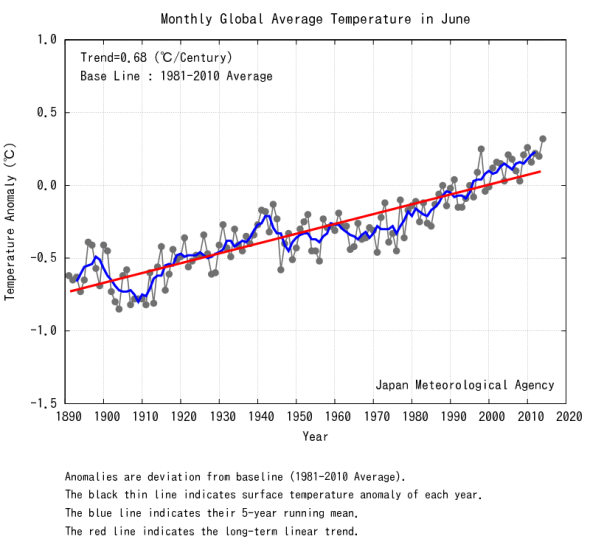New data released Monday shows humanity has just unlocked another achievement in the race to cook the planet: The last three months were collectively the warmest ever experienced since record-keeping began in the late 1800s.
The Japan Meteorological Agency said June 2014 was the warmest June globally since at least 1891, when its dataset begins. This follows May 2014, which was the warmest May globally on record, which follows April 2014, which was the warmest April globally on record.
Taken as a whole, the just-finished three-month period was about 0.68 degrees Celsius (1.22 degrees Fahrenheit) above the 20th-century average. That may not sound like much, but the added warmth has been enough to provide a nudge to a litany of weather and climate events worldwide. Arctic sea ice is trending near record lows for this time of year, abnormally warm ocean water helped spawn the earliest hurricane ever recorded to make landfall in North Carolina, and a rash of heat waves have plagued cities from India to California to the Middle East. In addition to the relentless push by human-caused global warming, this year’s extra heat comes in part because of a building El Niño emerging in the Pacific.

Image: Japan Meteorological Agency
Also on Monday, NASA released its monthly global temperature numbers for June, with nearly identical results that were reached by a different method. According to NASA, June was the all-time third warmest, May was the warmest, and April was tied for second, with 2010 nudging out 2014 by an imperceptible 0.003 degrees Celsius in the three-month average. The two datasets are among the gold standards for keeping track of Earth’s escalating fever.
The statistics are akin to splitting hairs on a camel’s fracturing back (the camel being Earth, of course): The three hottest April-May-June periods (2014, 2010, and 1998) are essentially indistinguishable, differing by about 0.06 degrees Celsius according to JMA or about 0.01 degrees Celsius according to NASA.
In April, atmospheric carbon dioxide levels reached a monthly average of 400 parts per million for the first time in at least 800,000 years.